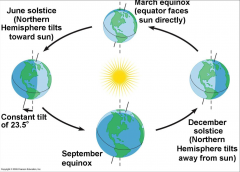![]()
![]()
![]()
Use LEFT and RIGHT arrow keys to navigate between flashcards;
Use UP and DOWN arrow keys to flip the card;
H to show hint;
A reads text to speech;
39 Cards in this Set
- Front
- Back
|
Ecology |
scientific study of the interactions btw organisms and their environments relationships among organisms and their interaction with the environment patterns and causes of the abundance and distribution of organisms |
|
|
Ecosystem |
biotic community and its abiotic components functioning as a system |
|
|
How do the organisms of an ecosystem relate? |
organismal -> population ecology -> community ecology -> ecosystem ecology & landscape ecology |
|
|
Climate |
average weather conditions in an area over a long period of time |
|
|
What are 4 abiotic factors that influence climate |
temperature, precipitation, wind, sunlight |
|
|
Global climate patterns are largely determined by? (2 things) |
input of solar energy , planet's movement in space |
|
|
warming effect of sun causes temp variations, which drive ____ and circulation of ______ and _____. |
evaporation, circulation of air and water |
|
|
soltices and equinoxes (diagram) |

|
|
|
greatest annual input and least seasonal variation in solar radiation is in _______ |
tropics |
|
|
Explain surface global air circulation |

|
|
|
Tropics: Trade winds |
winds blow from E to W |
|
|
Temperate: Westerlies |
winds blow from W to E |
|
|
Precipitation is highest where? |
tropics/equatorial regions and declines as you move north to south |
|
|
Intertropical convergence zone |
ITCZ - where the northeasterly and south easterly trade winds meet (air mass piles up and warm humid air rises and cools, releasing water. not stationary but migrates to region with warmest surface temp |
|
|
specific heat is lower on land or water? |
land |
|
|
ocean currents |
created by winds, the planet rotation, unequal heating of surface waters and the location and shapes of continents |
|
|
gyres |
great circular motions formed as the warm water moves away from the equator |
|
|
Biome |
environment that is defined by its climatic and geographic attributes characterized by ecologically similar organisms |
|
|
Terrestrial biomes |
categorized by climate and plant life |
|
|
aquatic biomes |
primarily by their physical environment (freshwater vs marine) |
|
|
oceans cover ___% of earth's surface |
75% |
|
|
zonation of aquatic environments depend on what factors? |
depth, light penetration, distance from shore and position in pelagic benthic zone |
|
|
marine benthic zone |
seafloor below the surface waters of the coastal zone and the offshore pelagic zone. organisms in abyssal zone are adapted to dark, cold, extreme high pressure |
|
|
bioluminescence
|
chemical reaction that produces light |
|
|
_________ of aquatic biomes leads to seasonal turnover in the many temperate lakes |
stratifcation |
|
|
What are some examples of threats to habitats of aquatic biomes |
overfishing, bottom trolling, dumping of sewage and wastewater (pollution), invasive species, contamination, alteration of flow, development |
|
|
tropical forests (1st terrestrial biome) |
occur in warm, moist belt along the equator (hi temp year round) |
|
|
Tropical rainforests |
rainfall constant, most species rich and productive biome |
|
|
tropical dry forests |
seasonal precipitation, taller trees that lose leaves during long hot, dry season. |
|
|
Deserts (terrestrial biomes #2) |
low and unpredictable rainfall |
|
|
Tropical savannas (terrestrial biomes #3) |
drier tropical areas (some non tropical) microenvironments of higher soil nutrients and moisture are found under tree canopies support large diversity of herbivores that graze or browse the vegetation large # of insects, carnivores, scavengers are also supported |
|
|
Chaparral (terr biome #4) |
shrubland with cool rainy winters and dry hot summers adapted to periodic fires animals include browsing deer, fruit eating birds, seed-eating rodents, lizards, snakes |
|
|
temperate grasslands (terr biome #5) |
found in interiors of the continents, where winters are cold drought, fires and grazing animals prevent trees from growing; deep fertile soils MIDWEST USA |
|
|
Coniferous forest (terr biome #6) |
taiga: long cold winters & relatively warm summers favors evergreen trees dominant animals: moose, hares, rodents, birds, insects. LARGEST BIOME ON EARTH |
|
|
Temperate broadleaf forests (terr biome #7) |
cold winters and warm moist summers found where there is sufficient moisture to support the growth of large trees lots of tree species, permanent residents and migrant animals, some hibernate in burrows |
|
|
Tundra (terr biome #8) |
found in arctic and high elevations at all latitudes (alpine tundra) treeless biome characterized by extreme cold, wind and permafrost |
|
|
arctic tundra |
lies between the taiga and permanently frozen polar regions |
|
|
what kinds of plants are in the tundra?
|
photosynth 3 months of the year erect leaves for complete interception of solar radiation and they photo synth during the 24 hour daylight periods. most of the photosynthate goes into the production of new growth (roots) |
|
|
what kind of animals in tundra? |
herbivores (caribou, lemmings, arctic hares, musk oxen) Carnivores (wolf, arctic fox, snowy owls) |

